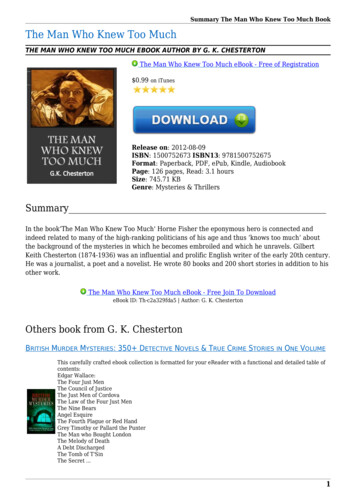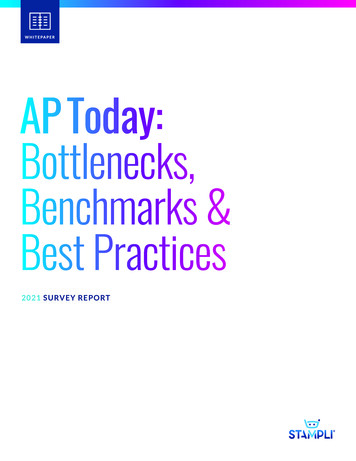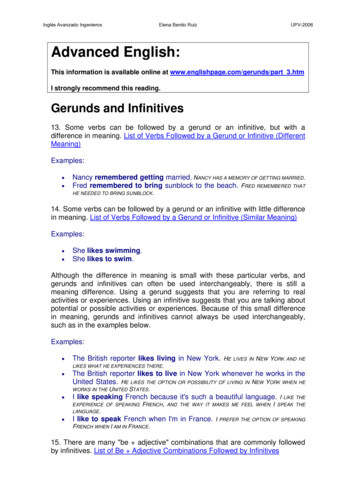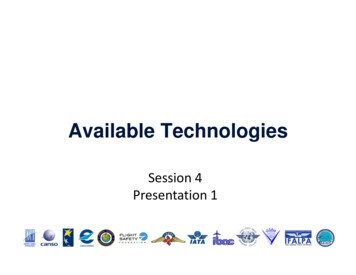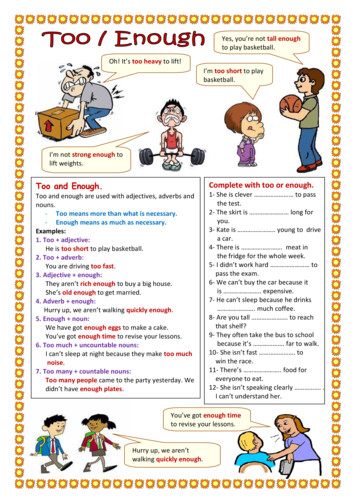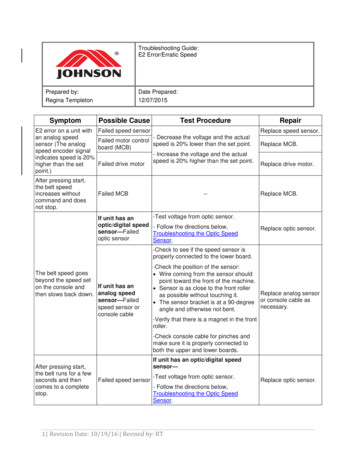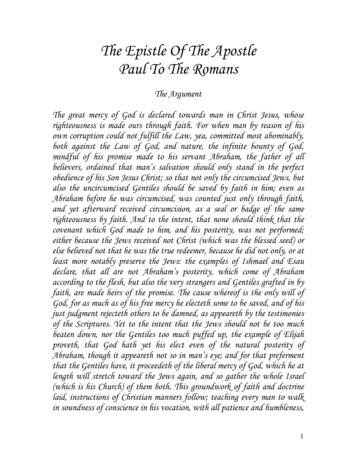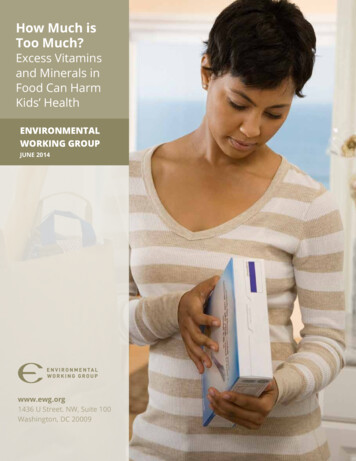
Transcription
How Much isToo Much?Excess Vitaminsand Minerals inFood Can HarmKids’ HealthENVIRONMENTALWORKING GROUPJUNE 2014www.ewg.org1436 U Street. NW, Suite 100Washington, DC 20009
Contentswww.ewg.orgResearchersOlga NaidenkoRenee Sharp3 Executive Summary5 Up to half of children 8 and younger get too much vitamin A,zinc and niacin8 Sources of added vitamins and minerals in children’s food10 EWG identified 23 excessively fortified cereals12 Snack bars: another source of added nutrients13 Harmful effects of excess vitamins and mineralsEditorNils BruzeliusDesignerAman AndersonTy Yalniz15 Vitamin supplementation trials underscore potential risks16 How much is too much?17 Outdated Daily Values, industry marketing, put children atrisk18 EWG’s Recommendations29 AppendicesAbout EWGThe Environmental Working Groupis the nation’s most effectiveenvironmental health research andadvocacy organization. Our missionis to conduct original, game-changingresearch that inspires people,businesses and governments to takeaction to protect human health andthe environment. With your help –and with the help of hundreds oforganizations with whom we partner –we are creating a healthier and cleanerenvironment for the next generationand beyond.Reprint PermissionTo request reprint permission, pleaseemail a completed request form topermissionrequests@ewg.orgACKNOWLEDGEMENTS:We thank Dr. Jocelyn Sacco for reviewing the draft report and providinginsightful comments. We also thank EWG colleagues Dawn Undurraga, SeanGray and Nneka Leiba for their help throughout the project.The opinions expressed in this report are those of the authors and do notnecessarily reflect the views of funders or reviewers.DISCLAIMERThe conclusions and findings that appear in this report reflect EWG’sresearch at the time of publication. In light of evolving market conditions,subsequent product reformulations and other factors, they may no longerbe current. EWG makes no representations or warranties about any ofthe products that may appear in this document. EWG hereby disclaims allwarranties with regard to any of the products that may appear in this report,including express, statutory, implied warranties of merchantability or fitnessfor a particular use.2EWG.orgToo Much of a Good ThingHEADQUARTERS1436 U Street. NW, Suite 100Washington, DC 20009(202) 667-6982CALIFORNIA OFFICE2201 Broadway, Suite 308Oakland, CA 94612MIDWEST OFFICE103 E. 6th Street, Suite 201Ames, IA 50010SACRAMENTO OFFICE1107 9th Street, Suite 625Sacramento, CA 95814
How Much is Too Much?Excess Vitamins and Minerals in Food Can HarmKids’ HealthExecutive SummaryGetting sufficient amounts of key nutrients isimportant for a healthy diet, but many Americansdon’t realize that consuming excessive amounts ofsome nutrients can be harmful. Food producersoften fortify foods with large amounts of vitaminsand minerals to make their products appear morenutritious so they will sell better. Because the Foodand Drug Administration’s current dietary DailyValues for most vitamins and minerals were set in1968 and are woefully outdated, some productsmay contain fortified nutrients in amounts muchgreater than the levels deemed safe by the Instituteof Medicine, a branch of the National Academy ofSciences.EWG’s review of fortified foods currently on themarket found that young children are at risk ofconsuming too much of three nutrients – vitamin A,zinc and niacin. Fortified breakfast cereals are thenumber one source of excessive intake becauseall three nutrients are added to fortified foods inamounts calculated for adults, not children. TheFDA’s current Daily Values for these three nutrientsare actually higher than the “Tolerable Upper IntakeLevel” calculated by the Institute of Medicine forchildren 8 and younger. Pregnant women and olderadults may also be at risk of consuming too muchvitamin A from other fortified foods, such as snackbars.Nutrient content claims are used as marketingtools. High fortification levels in a product can induceconsumers to buy certain foods because they seem“healthier” even though they might not be, as theInstitute of Medicine has pointed out in multiplereports (IOM 1990; IOM 2010).Vitamin A, zinc, and niacin are all necessary forhealth, but too high doses can cause toxic symptoms.Routinely ingesting too much vitamin A from foodssuch as liver or supplements can over time lead toliver damage, skeletal abnormalities, peeling skin,brittle nails and hair loss. These effects can be shortterm or long lasting. In older adults, high vitaminA intake has been linked to hip fractures. Takingtoo much vitamin A during pregnancy can result indevelopmental abnormalities in the fetus. High zincintakes can impair copper absorption and negativelyaffect red and white blood cells and immune function.Niacin is less toxic than vitamin A and zinc, butconsuming too much can cause short-term symptomssuch as rash, nausea and vomiting.Although many Americans do not eat enoughvitamin-rich vegetables, fruits and other freshproducts and consequently get too little of somevitamins and minerals, ingesting excessive amountsis also unhealthy. Data from the National Health andNutrition Examination Survey (NHANES) show thatwith the exception of vitamins D and E and calcium,dietary deficiencies of vitamins and minerals are rareamong children 8 and younger in the United States(Berner 2014). For young children, the problem isthe opposite – the risk of too much intake of somenutrients from fortified foods and supplements(Bailey 2012a; Butte 2010).One recent study by a joint research team ofthe National Institutes of Health and CaliforniaPolytechnic State University found that childrenyounger than 8 are at risk of consuming vitaminA, zinc and niacin at levels above the Institute ofMedicine’s Tolerable Upper Intake Level. The studyfound that from food alone, including naturallyoccurring and fortified sources, 45 percent of 2-to-8year-old children consume too much zinc, 13 percentget too much vitamin A and 8 percent consume tooEnvironmental Working Group3
much niacin (Berner 2014). Similar results have beenpublished by the FDA itself (FDA 2014a) and by aresearch group at the University of Toronto (Sacco2013). In contrast, eating fresh foods that naturallycontain vitamins and minerals has significant healthbenefits and, with very few exceptions, has not beenlinked to excessive vitamin and mineral intake.It is difficult or impossible to link these nutrientoverexposures to specific cases of harm to children’shealth, but multiple studies point out that cumulativeexposures from fortified food and supplements couldput children at risk for potential adverse effects (IOM2003; IOM 2005). Multiple expert reviews conductedin the United States and in Europe have highlightedthe health risks of high vitamin and mineralfortification of foods (BfR 2005; BfR 2006; EFSA 2006;IOM 2001; UK EVM 2003).EWG analyzed the data on Nutrition Facts labels forbreakfast cereals and snack bars, two food categoriesthat are frequently fortified and heavily marketedfor children. EWG’s analysis was based on datagathered by FoodEssentials, a company that compilesinformation on foods sold in American supermarkets.EWG reviewed 1,556 breakfast cereals and 1,025snack bars, identifying 114 cereals fortified with 30percent or more of the adult Daily Value for vitamin A,zinc and/or niacin and 27 snack bars fortified with 50percent or more of the adult Daily Value for at leastone of these nutrients.A number of factors make children’s excessiveintake of vitamin A, zinc and niacin a health concern: 4These micronutrients are present naturallyin food and are also added to many foodschildren and toddlers eat, including milk, meat,enriched bread and snacks.Many cereals and snack bars are fortified atlevels that the FDA considers high, exceedingthe amounts children need and in some casesexceeding the safe upper limits for youngchildren in a single serving.Intentional or accidental fortification “overages”by manufacturers can make actual exposuresgreater than the amounts indicated on thenutrition label.Many children eat more than a single servingEWG.orgToo Much of a Good Thingat a sitting because the serving sizes listed onmany packaged foods do not reflect the largeramounts people actually eat. A third of all children, and as many as 45percent of the younger age groups, take dietarysupplements (Bailey 2013).Excessive exposure to fortified nutrients is theresult of unscrupulous marketing, flawed nutritionlabeling and outdated fortification policy. The currentnutrition labeling system puts children’s health atrisk and is in dire need of reform. The FDA’s recentlyproposed reforms (FDA 2014b; FDA 2014c) are a stepin the right direction, but they remain insufficient toprotect children’s health from over-consumption offortified micronutrients.To address these problems, the FDA must setpercent Daily Value levels that reflect current science;require nutrition labels on products marketed forchildren to display percent Daily Values specific to eachage group, such as 1-to-3-year-olds and 4-to-8-year-olds;and update the serving sizes cited on Nutrition Facts labelsto accurately reflect the larger amounts that Americansactually eat. The FDA should also modernize its 1980guidelines on voluntary food supplementation, particularlyfor products that children eight years old and younger mayeat. Food fortification policy must be based on specific riskassessments for each nutrient and for specific populationgroups.EWG recommends that parents give their childrenproducts with no more than 20-to-25 percent of theadult Daily Value for vitamin A, zinc and niacin andmonitor their children’s intake of these and other foodsso kids do not get too much of these nutrients. Becausetoo much vitamin A can cause birth defects, EWG alsorecommends that pregnant women watch their intakeof products fortified with vitamin A, especially if they aretaking a vitamin pill. Older adults should also carefullymonitor vitamin A in their diets and supplementsin order to avoid the risks of osteoporosis and hipfractures associated with high vitamin A intake.Finally, it is critical that the FDA take seriously thequestion of how food manufacturers may misuse foodfortification guidelines and nutrient content claims tosell more products, particularly those of little nutritionalvalue.
Full ReportUP TO HALF OF YOUNGCHILDREN GET TOO MUCHVITAMIN A, ZINC AND NIACIN.For vitamins and minerals, there are health risks toconsuming too much as well as too little. Adequateamounts are essential to maintain health and preventdisease, and historically deficiencies of essential vitamins have caused diseases such as scurvy, pellagraand rickets. In developed countries, however, economic advances over the last century have significantly improved diets, resulting in a better dietary supplyof many nutrients.Paradoxically, however, widespread use of dietarysupplements and extensive mandatory and voluntaryfortification of foods with vitamins and minerals havecreated the opposite danger – excessive intake. It’sstill important for everyone to get an adequate supplyof micronutrients, but it is also vital to make surepeople don’t get too much of certain vitamins andminerals, because overconsumption can also causehealth problems (BfR 2005; BfR 2006; Dwyer 2014;IOM 2003).Between 1997 and 2001, the Institute of Medicinecalculated what it calls Tolerable Upper IntakeLevels (UL) for various nutrients, which it definedas “the highest level of daily nutrient intake that islikely to pose no risk of adverse health effects toalmost all individuals in the general population.” Asintake increases above these upper levels, the riskof harmful effects increases (IOM 1998a). TolerableUpper Intake Levels were calculated for specificage groups because both the daily needs and thetolerance of excess nutrients vary depending on bodysize and specific nutritional requirements (VerkaikKloosterman 2012; IOM 1998a). The European UnionTABLE 1Many 2-to-8-year-old children are at risk of excessive nutrient intakeFortified nutrientHealth effectsassociated withexcessive intakePercentage of 2-to-8-year-old childrenexceeding IOM’s tolerable intake level *Children who don’t takesupplementsChildren who takesupplementsEstimated numberof 2-to-8-yearolds over-exposedfrom food andsupplements **Vitamin ALiver damage; brittlenails; hair loss; skeletalabnormalities; osteoporosis and hip fracture (inolder adults); developmental abnormalities (ofthe fetus)13%72%10.6 millionZincImpaired copper absorption; anemia; changesin red and white bloodcells; impaired immunefunction45%53-84%13.5-17.2 millionNiacin (B3)Skin reactions (flushing, rash); nausea; livertoxicity8%28%4.7 million* Data from Bailey 2012a and Berner 2014. Bailey reported that 84 percent of supplement users exceed the UL for zinc; Berner reported that 53percent of supplement users exceed the UL for zinc.** 42 percent of 2-to-8-year-olds take supplements (Bailey 2012a). The number of children in the 2-to-8 age group is 28 million, according to the2010 Census data (4 million children per age year). For the 58 percent who do not use supplements, the overexposed population is based onfood alone (third column). For the 42 percent who do take supplements, overexposed population based on both food and supplements (fourthcolumn). The two numbers were added to estimate the total number overexposed from both sources.Environmental Working Group5
and the United Kingdom conductedtheir own assessments of the safeupper amount of vitamin and mineralintake and established upper limits orguidance levels that are similar overallto those of the Institute of Medicine(EFSA 2006; UK EVM 2003).According to a recently publishedanalysis of dietary intake data fromthe National Health and NutritionExamination Survey 2003-2006, fromfood alone 8 percent of 2-to-8-yearold children consume too muchniacin, 13 percent consume too muchvitamin A and 45 percent consumetoo much zinc (Berner 2014). Thisanalysis included both naturallyoccurring and fortified micronutrientsin food. Potential over-exposuresare much higher among the 42percent of children in this age groupwhose parents give them dietarysupplements (Bailey 2012a). Thesesupplements vary greatly and caninclude multivitamins, multivitaminswith minerals or individual vitaminsand mineral preparations (Bailey2013). Many supplements, suchas gummy vitamins, have beendeveloped to make them morepalatable to children.Taking into account bothsupplement users and non-users, EWGcalculated that more than 10 millionAmerican children are getting too muchvitamin A; more than 13 million get toomuch zinc; and nearly 5 million get toomuch niacin (Table 1).The data in Table 1 agree with theFDA’s analysis that 33 percent of 4-to-8year-old children ingest zinc in excess ofthe IOM’s Tolerable Upper Intake Leveland 26 percent are over-exposed tovitamin A (FDA 2014a). The FDA did notanalyze niacin intake (FDA 2014a).6EWG.orgWhat Major StudiesHave Concluded:“More than 7 percent of children (2–8 y) usuallyhave nutrient intakes from foods alone that exceedthe UL [Tolerable Upper Intake Level] for copper,selenium, folic acid, vitamin A and zinc, with zincbeing the most notable (45 percent of [supplement]non-users and 84 percent of [supplement] usersreporting usual intakes UL)” (Bailey 2012a).“Supplement use did increase the prevalenceof intakes above the UL for iron, zinc, vitamin Aand folic acid in all age groups and for vitaminC, copper, and selenium in those 2–8 y.” (Bailey2012a).“Intakes of synthetic folate, preformed vitamin A*,zinc, and sodium exceeded Tolerable Upper IntakeLevel in a significant proportion of toddlers andpreschoolers” (Butte 2010).“High proportions of formula-fed WIC infants andWIC children ages 1 through 4 years had estimatedusual intakes of zinc and preformed vitamin A thatexceeded the UL” (Institute of Medicine 2005).* Preformed vitamin A refers to retinol, retinyl palmitate, or retinylacetate, which are readily converted in the body into retinoic acid,the active form of vitamin A. The activity of preformed vitamin Ais 12-to-24-times greater than that of of carotenoids such as betacarotene, which are vitamin A precursors.Too Much of a Good Thing
Routinely ingesting too much vitamin A overconsumers perceive the overall healthfulness of foodsa long time — from foods such as liver, fortified(Drewnowski 2010). One recent study of parentsfoods or supplements — can lead to liver damage,of school-age children found that half were moreskeletal abnormalities, peeling skin, brittle nails andwilling to buy cereals that carried a nutrition claimhair loss. These effects can be short-term or longeven though the products were of below averagelasting. In older adults, high vitaminA intake has been linked to hipfractures. Taking too much vitaminA during pregnancy can result indevelopmental abnormalities in the – Marion Nestle, author and professor of nutrition, food studies and publicfetus. High zinc intakes can impairhealth, New York University (2013)copper absorption and negativelyaffect red and white blood cells and immunenutritional quality (Harris 2011a). The authors wrotefunction. Niacin is less toxic than vitamin A and zinc,that the nutrition- related claims “have the potentialbut excessive niacin intake can cause short-termto mislead a significant portion of consumers” (Harrissymptoms such as rash, nausea and vomiting.2011a).“Added nutrients are about marketing,not health.”In a 2005 report for the federal Women, Infantsand Children (WIC) nutrition program, the Instituteof Medicine warned that excessive exposure todietary vitamin A and zinc posed a risk to formula-fedinfants and 1-to-4-year-olds. In a more recent study,researchers at the Baylor College of Medicine, theNIH Office of Dietary Supplements and Nestlé InfantNutrition reported that when all sources of nutritionwere combined, 59 percent of 2-to-4-year-old childrenexceeded the Upper Intake Level for vitamin A and 72percent exceeded the limit for zinc (Butte 2010).Overconsumption of these nutrients is less ofa concern for older children because their greaterbody weight raises both their nutritional needs andtolerable upper intake levels. However, even 9-to-13year-olds who take daily multivitamins and consumefortified foods may ingest too much zinc and vitaminA. About 32 percent of 9-to-13-year-olds that takesupplements exceed the Institute of Medicine’supper limit for zinc, and 21 percent exceed the limitfor vitamin A (Bailey 2012a). Niacin intake from allsources exceeds the upper limit in 11 percent of9-to13-year-old children (Berner 2014).There are two major reasons for children’sexcessive consumption of fortified nutrients in food:industry marketing and the FDA’s outdated system ofnutrition labeling.As EWG detailed in its May 2014 report, “Children’sCereals: Sugar By the Pound,” research has shownthat nutrition claims on packaging influences howOther experts on food labeling have come to thesame conclusion. Jennifer Pomeranz, a professor oflaw and public health at Temple University, wrote lastyear in the American Journal of Law and Medicinethat, “Perhaps the most problematic result of theselax regulations is that products high in added sugarcarry a wide variety of nutrient content claims, whichmisleadingly convey healthfulness in an otherwiseunhealthy product” (Pomeranz 2013).Dr. Marion Nestle, the renowned author andprofessor of nutrition at New York University,summed it up best in an August 2013 blog post titled,“FDA study: Do added nutrients sell products? (Ofcourse they do).” She wrote:“Food marketers know perfectly well that nutrientssell food products. The whole point of doing so is to beable to make nutrient-content claims on package labels Plenty of research demonstrates that nutrients sell foodproducts. Any health or health-like claim on a foodproduct – vitamins added, no trans fats, organic – makespeople believe that the product has fewer calories andis a health food As I keep saying, added vitamins areabout marketing, not health.” (Nestle 2013)The Food and Drug Administration’s system ofNutrition Facts labels would be one way to counterindustry’s misleading marketing. Instead the labelscompound the problem, because the labels’ percentDaily Values for nutrition content are outdated andare based only on adult dietary needs. Many of theFDA Daily Value levels were set in 1968 — moreEnvironmental Working Group7
than 40 years ago — when nutritional deficiencieswere still the primary concern. And the FDA doesnot require age-appropriate Daily Value labeling onproducts specifically targeted at children.unenforceable and outdated food fortificationpolicy, millions of children are ingesting potentiallyunhealthy amounts of vitamins and minerals fromfortified foods.When a consumer picks up a box of cereal coveredin cartoon characters that is clearly marketed to childrenand sees that one serving provides 50 percent of theDaily Value for vitamin A, she may think that it provides50 percent of a child’s recommended intake. She wouldmost likely be wrong. If the label has the signaturesmall-print phrase, “Percent Daily Values are based on a2,000 calorie diet,” that means that the nutrition label isbased on the adult Daily Values.Moreover, for vitamin A, zinc and niacin, thenumbers described by FDA as “Daily Value for adultsand children 4 or more years of age” actually exceedthe Tolerable Upper Intake Levels for children 8 andyounger (Table 2).SOURCES OF ADDED VITAMINSAND MINERALS IN CHILDREN’SFOODVitamin A, zinc and niacin all occur naturally. Theyare also added to foods that young children eatregularly (Table 3).Vitamin AWhile a few products marketed for toddlersand young children do voluntarily list Daily Valuesspecific for this age group, the FDA does notrequire such labeling. EWG found two brand-nameproducts currently on the market that have labelsfor both adults and children younger than 4 — PostC is for Cereal and General Mills’ Cheerios (originalformulation). The vast majority of cereals — includingmost children’s cereals — display just one set of DailyValues, those for adults.Vitamin A is the common name for a group offat-soluble substances present in two forms in food:preformed vitamin A (retinol and retinyl esters suchas retinyl palmitate and retinyl acetate) and vitaminA precursor carotenoids (beta-carotene, alphacarotene, and many others) that the body convertsinto retinol or retinoic acid. Vitamin A precursors arealso called provitamin A. Different chemical formsof vitamin A play specific roles in the body. Retinol isimportant for eyesight. Retinoic acid supports normalbody growth and development and plays a criticalrole in the formation and maintenance of organsand tissues. Retinoic acid is also a key regulator ofnumerous growth and metabolic processes.As a result of the excessively high Daily Valuesused for nutrition labeling and the FDA’s lax,Preformed vitamin A such as retinyl palmitate israpidly converted first to retinol and then to retinoicTABLE 2Nutrition Label Daily Values for vitamin A, zinc and niacin exceed Tolerable Upper IntakeLevels for children 8 and youngerTolerable Upper IntakeLevel for 1-to-3-year-oldchildrenTolerable Upper IntakeLevel for 4-to-8-year-oldchildrenVitamin A*600 microgram RAE/day900 microgram RAE/day5,000 IU (1,500 microgramRAE)Zinc7 mg/day12 mg/day15 mg/dayNiacin10 mg/day15 mg/day20 mg/dayFortified nutrientCurrent FDA Daily Value foradults and children 4-yearsold and up* RAE (retinol activity equivalents) is the measure used today for expressing vitamin A activity. Health concerns apply only to preformed vitaminA, such as retinyl palmitate or retinol, not to naturally occurring vitamin A precursors such as beta-carotene and other carotenoids. The currentFDA Daily Value for vitamin A is expressed in the outdated form of international units (IU). 5,000 IU correspond to 1,500 μg (micrograms) ofretinol activity equivalents (RAE).8EWG.orgToo Much of a Good Thing
acid. Excessive production of retinoic acid caused byingesting large amounts of preformed vitamin A candisrupt bodily functions and cause overt toxicity.In contrast, ingesting large amounts of naturallyoccurring dietary provitamin A carotenoids is notassociated with toxicity. That’s because it takesmultiple metabolic reactions to convert provitaminA precursors into retinol, generating relatively smallamounts of both retinol and retinoic acid. Retinol has12 times the activity of beta-carotene and 24 timesthe activity of alpha-carotene.Preformed vitamin A occurs naturally in dairyproducts, eggs, fish and meat, especially liver.Carotenoids are found in bright yellow and orangevegetables such as carrots, pumpkin and sweetpotatoes, broccoli and spinach. Preformed vitamin A,either as retinyl palmitate (most common) or retinylacetate, is frequently added to milk and milk-baseddrinks, butter spreads, cereals, snack bars, cookiesand cakes.The FDA has rules regarding vitamin A fortificationof butter spreads (margarine) and milk. Butterspreads typically contain 10 percent of the adult DailyValue per serving. Fortified milk can contain 10-15percent of the adult Daily Value per serving. There areno limits on vitamin A fortification of other foods.NiacinNiacin, or vitamin B3, encompasses nicotinic acid,niacinamide (also called nicotinamide or nicotinic acidamide) and their derivatives. Niacin occurs naturallyin foods such as meat, fish, sunflower seeds andpeanuts, as well as in whole grains such as wholewheat and brown rice. The liver can also synthesizeniacin from the amino acid tryptophan, a buildingblock for proteins.The Institute of Medicine concluded in 1998 thatniacin intake in the United States is “generous” (IOM1998). Nevertheless, food producers enrich a varietyof foods with additional niacin (often in the form ofniacinamide), including cereals, breads and flourbased dishes such as pizzas and cakes. While there isno evidence of harm from naturally occurring niacin,excess niacin in fortified foods or supplements hasbeen linked to harmful effects.TABLE 3Sources of added vitamin A, zinc and niacinin the diets of 2-to-8-year-old childrenFoodPercent contributionPreformed Vitamin AReady-to-eat cereal42.6%Milk25.1%Milk drinks11.7%Pasta dishes3.5%Margarine, butter3.1%NiacinReady-to-eat cereal51.6%Yeast bread, rolls10.4%Pizza6.9%Pasta dishes5.1%Cakes and cookies4.8%ZincReady-to-eat cereal96.8%Source: National Health and Nutrition Examination Survey 2003-2006,Berner 2014The FDA requires the addition of certainmicronutrients to processed grain foods suchas breads, corn meal, flour, macaroni and riceto compensate for the loss of these nutrientsduring flour bleaching and processing. The typicalmicronutrients added to enrich cereal grains arethiamin, riboflavin, niacin, iron and folic acid (Yamini2012). For niacin, the legally required enrichmentamount is 15-34 mg/pound, which provides 8-15percent of the adult Daily Value per serving,depending on the food. Breakfast cereals are oftenfortified to much higher levels, up to 100 percent ofthe adult Daily Value.ZincZinc is an essential mineral. It is naturally presentin many foods, including milk and meat products aswell as grain-based products. It is a component ofdietary supplements as well as cold lozenges andsome over-the-counter cold remedies. Breakfastcereals are the number one source of added zincin the diets of children. The FDA does not limit theamount of zinc added to fortified foods.Environmental Working Group9
EWG IDENTIFIED 23 EXCESSIVELYFORTIFIED CEREALSBecause the FDA’s current Daily Values for vitaminA, zinc and niacin are so out of sync with what theInstitute of Medicine considers healthy for children, asingle serving of some fortified foods can overexposethem to one or more of these nutrients.Fortified breakfast cereals are the numberone source of added vitamin A, zinc and niacin inchildren’s diets (Table 3). EWG analyzed the NutritionFacts panels of 1,556 cereals and identified 23 withthe highest added doses. A child age 8 or youngereating a single serving of any them would exceedIOM’s safe level. The 23 cereals with the highestadded nutrient levels include such popular and wellknown national brands as Kellogg’s and General Millsand store brands such as Food Lion, Safeway andStop & Shop (Table 4).EWG’s analysis was performed on data gathered byFoodEssentials, a company that compiles informationabout foods sold in American supermarkets. EWGalso reviewed manufacturers’ websites for dataconfirmation and to collect additional nutritioninformation. Cereal package label information wasgathered between Sept. 15, 2012 and March 13, 2014and represents a snapshot of the market over thatperiod. Overall, 1,334 labels dated from 2013, 205dated from 2014 and 17 dated from 2012.The cereals in Table 4 are not the only sourcesof concern. In all, 114 cereals contain 30 percent ormore of the adult Daily Value (DV) of either vitamin A,zinc or niacin in a single serving (summary statisticsin Table 5). Some cereals contained two of the threenutrients at 30 percent or more of the adult DailyValue (25 with zinc and niacin; 10 with vitamin A andniacin; 1 with zinc and vitamin A). Children who eatcereals that are high in one or more of these threenutrients along with other fortified foods and/orsupplements could easily be overexposed.EWG’s analysis shows that on average, cold cerealsare the most likely to be fortified and have the highestlevels of fortification, followed by instant hot cereals.Of the 114 cereals that provide 30 percent or higherof the adult Daily Value for vitamin A, zinc or niacin in10EWG.orgToo Much of a Good Thinga single serving, only one is a (non-instant) hot cereal,three are granolas, seven are instant hot cereals and103 are cold cereals.American children and adults often eat morethan a single serving of cereal daily because manymanufacturers list unrealistically small serving sizeson the Nutrition Facts label. Many cereal
email a completed request form to permissionrequestsewg.org HEADUARTERS 1436 U Street. NW, Suite 100 Washington, DC 20009 (202) 667-6982 CALIFORNIA OFFICE 2201 Broadway, Suite 308 Oakland, CA 94612 MIDWEST OFFICE 103 E. 6th Street, Suite 201 Ames, IA 50010 SACRAMENTO OFFICE 1107 9th Street, Suite 625 Sacramento, CA 95814 www.ewg.org Researchers .
